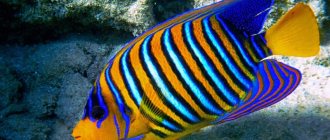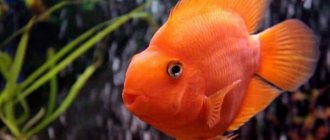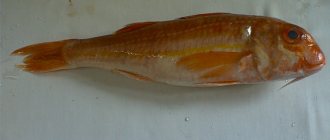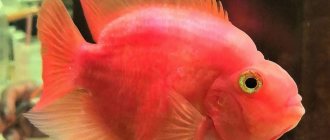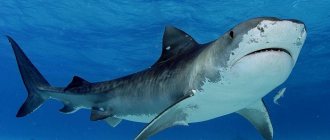The parrot fish, which will be discussed in this review, differs in many ways from other inhabitants of the water element. First of all, behavior after a bite. Grabbing the bait, using wide fins, it instantly rushes into shelter: stones, grottoes and reefs. The duration of the runs directly depends on the skill and patience of the angler himself. To minimize breaks, slips and the causes of exhausting fishing, read the article in which you will become familiar with the habits, diet and methods of catching this funny fish.
Content
- 1. General description of parrot fish
- 2. Distribution and habitats of parrot fish
- 3. Age and size
- 4. Lifestyle
- 4.1 Reproduction - time and characteristics of spawning
- 4.2 Diet - what to eat
- 5.1 Biting calendar - what time of year is the best time to bite?
- 5.2 In what weather does parrot fish bite best?
- 5.3 What are the best places to fish?
- 5.4 What gear is best to fish with?
- 5.5 Bait for parrot fishing
- 5.6 What baits and baits to fish with
- 5.7 How parrot fish bite
- 5.8 How to catch correctly - Basic techniques
- 5.9 Highlights
Composition and properties
The parrot fish has no electrical discharge, no spines, no poison. However, during her sleep, she produces a mucous membrane that protects her from attack by predators. In stores, fish are sold with this cover, because during catching, they begin to secrete their protective agent in large quantities. This substance is not dangerous to the human body. The product is saturated with a huge amount of vitamins (A, C, B, D), macro- and microelements, which ensure the normal functioning of all organs. In addition, fish fillet contains Omega-3 and Omega-6 - these are fatty acids that improve heart rate and normalize blood pressure. Parrot fish tastes amazing and has a fragrant smell. It is prepared in different ways, but it is recommended to use only gentle heat treatment methods. Because at high temperatures all useful substances evaporate from the product. The fish meat is elastic, but it has quite decent taste. And if you add a little lemon juice to the dish, you will truly discover all the delicate taste of this fish.
1. General description of parrot fish
The parrot fish, as it is commonly called, got its name because of its appearance. A narrow mouth and teeth fused with the jaws, the pelvic fins are larger and look like the wings of a bird, plus multi-colored body coloring. When the Thalassoma fish waves its fins, it strongly resembles not a fish, but a colorful parrot.
Thalassoma pavo is translated from Greek as sea-colored fish, and from Latin as peacock, a beautiful fish.
The parrot fish has a spindle-shaped body, a long dorsal fin, and no sections. The anal fin consists of 12 soft rays. Large, round scales in the amount of 26 - 31 scales. The tail is straight, in the form of a panicle. The belly is painted with vertical dark green stripes on a brown background, resembling a walnut. The body is blue along the edges, the head is dark red with blue tints. Females look less bright: yellow tones, with dark stripes.
Compatibility with other fish species
Parrot fish live peacefully with many species of their fellows. Both large peaceful fish and some representatives of the predatory world can get along well with them.
Parrots are not averse to eating small fish, so it is not recommended to house them with neons and gracilis. But the proximity of arowanas, labeos, blacklegs, medium and large catfish, barbs is quite suitable for parrot fish.
Distribution and habitats of parrot fish
Parrot fish lives in the warm waters of the Atlantic and Mediterranean Sea, where the water temperature is at least +20 degrees.
For lovers of fishing in sea waters, we suggest that you familiarize yourself with detailed information about the Mediterranean Sea, its weather conditions, relief, water temperature, water currents and inhabitants - Mediterranean Sea: description, history, interesting facts
Aquarium compatibility
Parrots are excellent for keeping in “cichlids” with similar neighbors, for example, Malawian cichlids (Labidochromis, Haplochromis), American cichlids (Cichlazomas severum, Geophagus). Parrots can also be kept with fish from other families that are similar in size and temperament, for example, rainbowfish, barbs, catfish, and calamoichts.
Due to the fact that parrots dig soil, it is quite difficult to keep plants in an aquarium with them. In addition, parrots gnaw and spoil the delicate leaves of plants. The solution to this issue is to decorate the aquarium with glandular plants grown to stones or driftwood, for example, anubias or inedible plants, such as elodea or cryptocorynes.
Another design option for an aquarium with parrots is the design in the “Pseudo-sea” style - when an imitation of a sea landscape is created in a freshwater aquarium, usually with artificial decorations - corals, shells, etc. The basis for such a solution can be a stadont decoration built into the aquarium.
Lifestyle
Leads a semi-predatory lifestyle. More often found in shallow water, at a depth of up to 20 meters. Capable of living at depths of up to 150 meters.
4.1. Reproduction - time and characteristics of spawning
May – July. Males lure females to secluded places where they create monogamous pairs or small harems.
At the end of August, the female lays eggs in the water, after which the male fertilizes her. The eggs are contained in a fatty shell and do not sink, but drift along the surface. After a few days, the larvae hatch and continue to live in surface waters until they reach 12–15 cm of age. After which they stop wandering and go down to their natural way of life: coral reefs, algae.
During spawning, if the male is absent, then the largest female in the harem, within 3–6 weeks, changes sex and performs male functions.
4.2. Diet - what to eat
Bivalves: oysters, mussels and scallops, also snails, algae and coral polyps. He devotes most of his life to plucking polyps growing on coral reefs and eating algae.
Underwater, even from a distance, you can hear the crunch of coral reefs gnawing. Hyman Island, Australia, short video
Social structure and reproduction
Photo: Parrotfish
During spawning periods, parrotfish gather in schools. In a flock there will always be one or two dominant males and several females. “But it happens that there is no male in the flock, and then a moment comes when one female, most often the oldest in the flock, has to change sex - to become a hermaphrodite.”
The gender reassignment process takes several weeks. Thus, the parrotfish becomes a hermaphrodite. Hermaphrodites are individuals that are capable of developing both eggs and sperm. This process can occur in a fish several times throughout its life. With the exception of one type - marble. This species does not change its sex.
After spawning, the eggs are fertilized by the male, and then carried into the lagoons by the current. The development of eggs occurs within a day, the fry appear, where they are in relative safety in the depths of the lagoon. This is where the larvae grow and feed on plankton.
As the fish grows from a fry to an adult, it goes through 2-3 stages where they change their color. The fry have a uniform color, with small stripes and specks. In immature individuals, purple, red or brown colors predominate. And the adult individual is already distinguished by bluish, green, and purple hues. Throughout its life, a parrot fish can change its color more than once.
As soon as the fry emerge from the larvae, they head to the coral polyps, where the main food is young algae. There they find shelter for themselves. The lifespan of a parrot fish in its natural habitat is approximately 9 - 11 years.
How, where, when and what to fish for parrot fish
You can catch parrotfish from the shore or from floating craft. During daylight hours, use natural and artificial baits.
5.1. Biting calendar - at what time of year the parrot fish bite best
Spring, summer and autumn.
5.2. What weather is the best time to bite?
In any weather except calm.
5.3. What are the best places to fish?
In shallow water, among algae and in coral reefs.
5.4. What gear is best to fish with?
To be sure to catch a parrot fish and get pleasant emotions from fishing, it is best to use the fly fishing method.
Fishing with this method implies important features:
- rod selection;
- coils;
- components accessories.
Fly fishing can be done in any depth of water. You should use a tackle of 2 - 4 bends, a reel with a conical fishing line capacity of 60 meters 0.40 mm.
Long-term fishing in the sun damages your eyesight and this should never be forgotten. Therefore, it is imperative to use anti-glare glasses. The participants who filmed this video in Australia, near the Whitsunday Islands, also mention this. Catching fish - parrot fly fishing on a fly
Patezim sunglasses, you can buy the product on the aliexpress website
Underwater hunting for peahens is in great demand among those who do not like to fish them out from under rocks. Here's how in this video, the diver shot a hefty bunch
Catching parrot fish using a remote controlled boat
If you are interested in a remote control boat, then you can Buy the product on the aliexpress website
The simplest gear consists of a fishing line and one hook. No float needed. The bait is algae. Throw near the shore, under rocks and wait for a jerk. The fishermen who filmed this video caught 30 parrotfish in this way in a short time
If you don’t have the means at hand, you can enter the water with only bread, feed and choose any fish you like. As in this video, in the village of Islamorada (Florida) it is often practiced
We must not forget that the tuki fish immediately swims into shelter after biting. After which it will be difficult to get it later, as you can see in this video
In the end, the one who is more persistent wins (continued)
Here is another video of a parrot fish using its trick of hiding under rocks. The hero of the plot is more tired of pulling her out of hiding than of fishing
5.5. Bait for parrot fishing
Porridge made from sardines and bread, or you can try it with fishmeal or kemah dagim.
5.6. What baits and baits to fish with
For the fly fishing method of catching parrot fish, an artificial fly is used - fly tying. You can do it at home, as shown in this video clip
The catchy fly fly from the aliexpress store website is in demand. Buy a product on the aliexpress website
Effective baits on a hook or jig head: crab legs, cuttlefish, nereis (estuary worm), dendrobene worm or dung worm.
Often fishermen independently catch nereis (sea worm) and walk along the shore with a sapper shovel, looking for muddy places. Many people mistakenly dig it in a row, like a vegetable garden - indiscriminately. In the end, nothing is found. You need to dig up from 4 sides, then take this layer with your hands and turn it upside down. Then the entire worm will be clearly visible.
A catchable bait is an isopodous crayfish running along the stones, the local name is dudu (emphasis on the first y). Here he is in the photo:
5.7. How does a parrot fish bite?
The bite is sharp and powerful.
5.8. How to fish correctly. — Basic techniques
Fast and smooth wiring.
5.9. The most important moments
After the bite, you need to deprive the fish of the opportunity to hide in the stones. To avoid exhausting fishing.
I want freedom and money. I'd like to sit on the deck and drink wine. And in the evening - ladies. A P Chekhov
DELICACIES No. 7 Parrot in salt.
2012sillybilly August 30th, 2012 Delicacies No. 5 Parrot fish in salt.
I first became acquainted with the Florida Keys somewhere in the mid-90s. After that, I went there many times to visit friends. We went out on a boat into the Gulf Stream and went fishing. Often the catch was a parrotfish. It’s strange, but the Americans released this nice-looking fish, saying that it tasted bad. In confirmation, they showed me a fish identification guide (a laminated plate with drawings of various fish, their names and taste qualities). Indeed, the guide said that parrot fish are inedible.
For the first time, I cooked parrotfish myself on the reefs of the Red Sea, because the local coral thickets were teeming with it. This is a fairly large colored fish, and is distinguished by its mouth similar to the beak of a parrot (hence the name). It feeds mainly on corals, but does not disdain mollusks. The coloring of this fish is very diverse, from blue to green. It is very easy to get it underwater using a Hawaiian spear, because the parrot fish is not shy and allows you to reach 0.7-1.2 m.
I’ll move on to the recipe itself, but note that it is suitable for almost any type of fish, from fatty salmon to dryish pike perch. You need to cut the fish’s belly (the smaller the cut, the better), remove the entrails, and leave the head untouched. It’s better to leave the scales too. Sprinkle 5-10mm of medium-ground sea salt onto aluminum foil (coarse will do). Place fish on top. Gently sprinkle it with a layer of salt, so that the salt does not get into the belly. The layer should cover the entire fish with a thickness of about 10mm. To prevent the salt from crumbling, you can lightly moisten it with water. Fold the edges of the foil up so that the fish is completely wrapped in it like a cocoon.
At the same time, you need to heat the grill at maximum heat and place the resulting aluminum bundle on the grill. Pour yourself a glass of dry white wine and wait 30-40 minutes until the appetizing smell of cooked fish comes out of the grill. Checking the readiness of fish is very simple. Pull the aluminum foil slightly from the side of the head. Stick a knife into the fish's head and twist slightly. The inside should be gray. If so, then the fish is ready. If blood is visible, then you need to wait a little longer. Sometimes before cooking I add “marinade” to the fish’s tummy.
All that remains is to remove the fish from the grill, place it on a tray and carefully remove the baked salt crust (it will come off in large pieces), making sure that the salt does not get on the fish. Next, it is better to transfer the fish to another dish, where it is easy to separate the skin along with the scales from the meat. Divide the fish among plates. Although the process of ridding the fish of the salt sacrophage itself is very exciting and can be done at the dinner table. I first tried fish according to this recipe in one of the Geneva restaurants in the mid-90s. It was a business lunch. The fish in a “cocoon” of salt was brought up on a serving table and the chef himself carefully freed it from the salt. Many years have passed, but I remember that fish. That was the first time I tried Chablis from a good vintage. I note that it is very difficult to find excellent dry white wine, usually sour or watery and unsaturated in taste.
One medium-sized fish requires 1.5-2 kg of salt. If you have not yet acquired a grill, then the fish according to this recipe can be cooked perfectly in a regular oven (about 250 degrees). Or on the beach in the sand over which there is a fire. Wait until the sand warms up. Move the coals to the side, place the fish in foil on the fire, lightly sprinkle it with hot sand, and cover it with coals on top. It will turn out to be a very romantic dinner even on a desert island, the main thing is not to forget to take a bottle of dry white there.
In these photos, the parrotfish is a bright turquoise, azure color. PS. Once I get the chance to cook fish according to this recipe, I’ll be sure to add more photos of the process. Take a look and active salivation is guaranteed. The most difficult thing in this recipe is to prevent grains of salt from getting on the pieces you are serving. I live on the shore of Ladoga, so I can’t look at the fish anymore. I would like to cook a piece of good filet mignon and polish it with dry red.
Parrot fish belong to the Cichlid family. This fish, artificially bred in the mid-20th century, is not found in nature. Its selection is based on representatives of American cichlids.
- Appearance, description
- Conditions of detention
- Feeding
- Aquarium compatibility
- Reproduction
- Reviews
Parrots are incredibly bright and attractive. Their coloring can be either monochromatic, for example, red and blue, or multi-colored, for example, a tattooed parrot. Parrots grow about 15-20 cm. They have a round, slightly laterally compressed body with large eyes and large lips. These cichlids live for about 10 years.
Interesting, unusual, funny facts about this fish
Names of this fish in other languages:
- Spanish - fredi;
- French - girelle paon;
- Albanian - vladika;
- Latin - thalassoma pavo.
In preparation for sleep, the peacock thalassoma secretes mucus from its mouth containing antibacterial substances and gradually envelops the fish. The salivary membrane is useful: it hides the smell from predators, protects against blood-sucking parasites and charges the fish with positive electrolytes. Serves as a kind of “protective bag”. Watch in a short video the formation of a mucous cocoon
And also, the parrot fish is naive, you can make a trap for it, the same one every day and every time it will fall into it.
Features of character and lifestyle
Photo: Parrot fish
The fish's lifestyle is mostly solitary. He tries to stay in “his” area, not far from his shelter, so that in case of danger he can hide in his house. Such places are located near coral reef gorges and caves. And it does not leave its habitat, since all the main food is available on the reefs.
As soon as night falls, the parrot fish secretes mucus around itself from its mouth, which forms a special protective film. This protection prevents the smell emanating from the fish from spreading and being detected by predators that hunt at night using their sense of smell. This method also helps to heal wounds that appear in fish from reefs, since the mucus has an antiseptic effect.
The fish spends up to 4% of its total energy on this procedure throughout the day. Such protection does not allow other blood-sucking parasites, such as isopods, from groups of crustaceans, to approach. To circulate water in the cocoon, the fish leaves holes on both sides, allowing water to pass freely. At dawn, she chews through this film with her sharp teeth and goes in search of food.
An interesting feature is that one parrotfish can produce up to 90 kilograms of sand annually due to its unusual diet.” As mentioned above, stones and pieces of coral, when they get into food along with algae, come out of it in the form of crushed sand. Such delicate and fine sand can be found on the shores of seas where parrotfish live.
Reviews from parrot fish owners
In the photo there is a red parrot and a tattooed parrot
Nita, review of the red parrot
Smart, like the entire cichlid series. They are extremely curious, you put your hand into the water, the rest swim away, and you definitely need to see who you are doing there. And what faces they make. Yes, they dig periodically, but anyone who has kept a cichlid for a long time probably knows how to dig citrons, asters, brules, etc. and the like. These animals take off everything, huge boulders, snags, and the hybrids are so-so, scattered in heap after heap, and only if they try to spawn. Like all large fish, they litter a lot when they eat.
taviu, review of the red parrot
Smart, unpretentious handsome men. They dig the soil and love rearrangements. My favorites! They dig the soil, of course! But this process is so interesting to watch, because they are “cleaning the area where to spawn eggs!” They pick up pebbles in their mouths, swim away and spit them all out in one pile. And they move the plants (I only have artificial ones in my parrot tank), it’s so interesting, it’s like they’re rearranging the furniture! Very unpretentious! Beautiful, bright, if you feed them the right food! And the intelligence is higher than that of some HOMO SAPIENS. It is better to place a flock of seven or more individuals in a large aquarium, them, and only them! You’ll watch your “House 2” later, but it will be more interesting here.
Galina, review of the red parrot
Cute sociable fish, easy to tame. They hid for about a month, now they practically take food out of our hands. They love it when you talk to them and react to your voice. They don’t dig the soil, they just pick up food for the catfish from above. Sometimes they “butt” the bots, but they are harmless and do not bite. I am very surprised when I hear that parrots supposedly bite. Maybe they also have subspecies? I didn’t even find any teeth on mine. When doing something in aqua, they like to watch their hands, but out of curiosity and hoping to grab a lost piece of food, they don’t grab their fingers.
Reproduction of parrot fish, preparation for spawning
By the time of spawning, the color of the fish becomes brighter. At this time, the parrots pair up and talk nest. Typically this period takes three days. The male arranges the home, cleans it of debris, and expands the entrance.
Irka, as a rule, is laid by the female in the evening. The male constantly pursues the female, trying to fertilize every egg. In most cases, the female lays up to 300 eggs during one spawning. If it is not fertilized, the eggs will die within a couple of days.
In the wild, parrots gather in flocks. It may turn out that the flock consists only of females and no males. Then the oldest female changes sex and does fertilization. But marbled parrots cannot change sex.
Parrot fish aquarium
The parrot is a picky fish. She will live well in the conditions that are offered to her. Accordingly, caring for them is simple. When choosing an aquarium, it is worth considering that parrots are very active. Therefore, they need a lot of free space to play. Accordingly, you should choose aquariums with a minimum capacity of 200 liters and a length of 70 cm. Be sure to use a lid, otherwise they will simply jump out.
To create a comfortable environment you definitely need:
- Filters for waste removal.
- An aerator or compressor to provide sufficient oxygen.
- A lamp for illumination, but you need to choose dim lamps. It is better to use red spectrum lamps to preserve color.
- Thermostat to maintain stable temperature.
- Underwater scenery to give you somewhere to hide.
Most equipment is purchased based on the size of the aquarium. Weak lighting and filters do not give any result, while a strong filter and aerator can give a slight current, but parrots do not like it.
Maintenance and care, nutrition, water requirements
Hybrids are easy to care for, so even novice breeders can handle them. The main thing is to create the right living conditions. At first, difficulties may arise with feeding, since due to their small mouth, aquarium inhabitants may refuse some food, but special food is sold that is intended specifically for this breed of fish.
First of all, you need to know that this fish has an irregular mouth shape, so it needs special food that would suit its size. In addition to granulated food, you need to periodically feed aquatic inhabitants with animal food, as well as regularly add vitamins that contain carotene. It keeps their color bright.
Parrots love sea fish very much, so you can sometimes treat them to this delicacy, but first you need to freeze the fillets thoroughly, in which case you don’t have to worry about introducing parasites or bacteria into the aquarium. In addition, you can add plant foods, namely:
- zucchini;
- peas;
- bell pepper;
- corn;
- lettuce leaves;
- dandelion.
The fish are worth watching. If she refuses vegetables, then you need to try feeding them other vegetation. Each individual reacts to vegetables in its own way.
Feeding should be strictly on schedule. This should be done twice a day - early in the morning and in the evening. In this case, all food that the fish have not eaten must be removed from the water. It is especially important to do this after the evening feeding, otherwise the fish will eat spoiled food in the morning, which can have a bad effect on them and cause illness.
A properly formulated diet affects the lifespan of aquarium inhabitants. It is extremely important not to overfeed them. Obesity will not allow them to move normally, and this can cause all sorts of diseases.
The tank in which yellow parrots are kept must be voluminous so that the fish can feel spacious. Small driftwood, pebbles and large ceramic elements are also placed on the bottom. These items will create a kind of shelter where timid cichlids can hide in case of danger.
It is especially important to do this when the fish have just been acquired and have not had time to get used to the environment. If you ignore the advice, your aquarium parrots will be under constant stress and may get sick.
It is necessary to equip the container with a powerful filter and do not forget to update the aquarium water weekly by at least 20% of the total volume. Water parameters should be as follows:
- temperature - from +24 °C to 27 °C;
- acid-base balance - 7 units;
- approximate hardness - up to 25 dGh.
A good layer of soil must be poured onto the bottom, in which the cichlids will happily swarm around. Sand or small pebbles are suitable for this, or you can mix both components.
As for lighting, parrots prefer moderate light. If the room in which the aquarium is located is too dark, additional lighting will be required. Experienced breeders advise purchasing lamps with a red glow. In this lighting, the color of the scales looks most advantageous.
Parrot fish diseases and their prevention
Parrot fish have a very strong immune system. But this does not guarantee the absence of diseases. You can determine the presence of a problem by black fins, the appearance of white lumps on the scales, lying on the ground for a long time, refusal to feed, and the appearance of wounds.
The most common concern is small black spots. They may appear or disappear. The main reason is stress. Parrots do not like changes in maintenance or relocation. But an ammonia burn is also possible.
Several pale spots may appear. This indicates an excess of nitrates in the water, that is, the fish has been poisoned. In this case, the soil must be disinfected in any way, and the water must be changed. After 2-3 days, the fish’s condition will recover without treatment.
Hexamitosis is possible. In this case, the stool becomes mucus-like and the fins become covered with red spots. Parrot fish stays in the upper layers of water, where there is more oxygen. To correct the situation, you need to change the water, add hydrogen peroxide or a weak solution of potassium permanganate.


